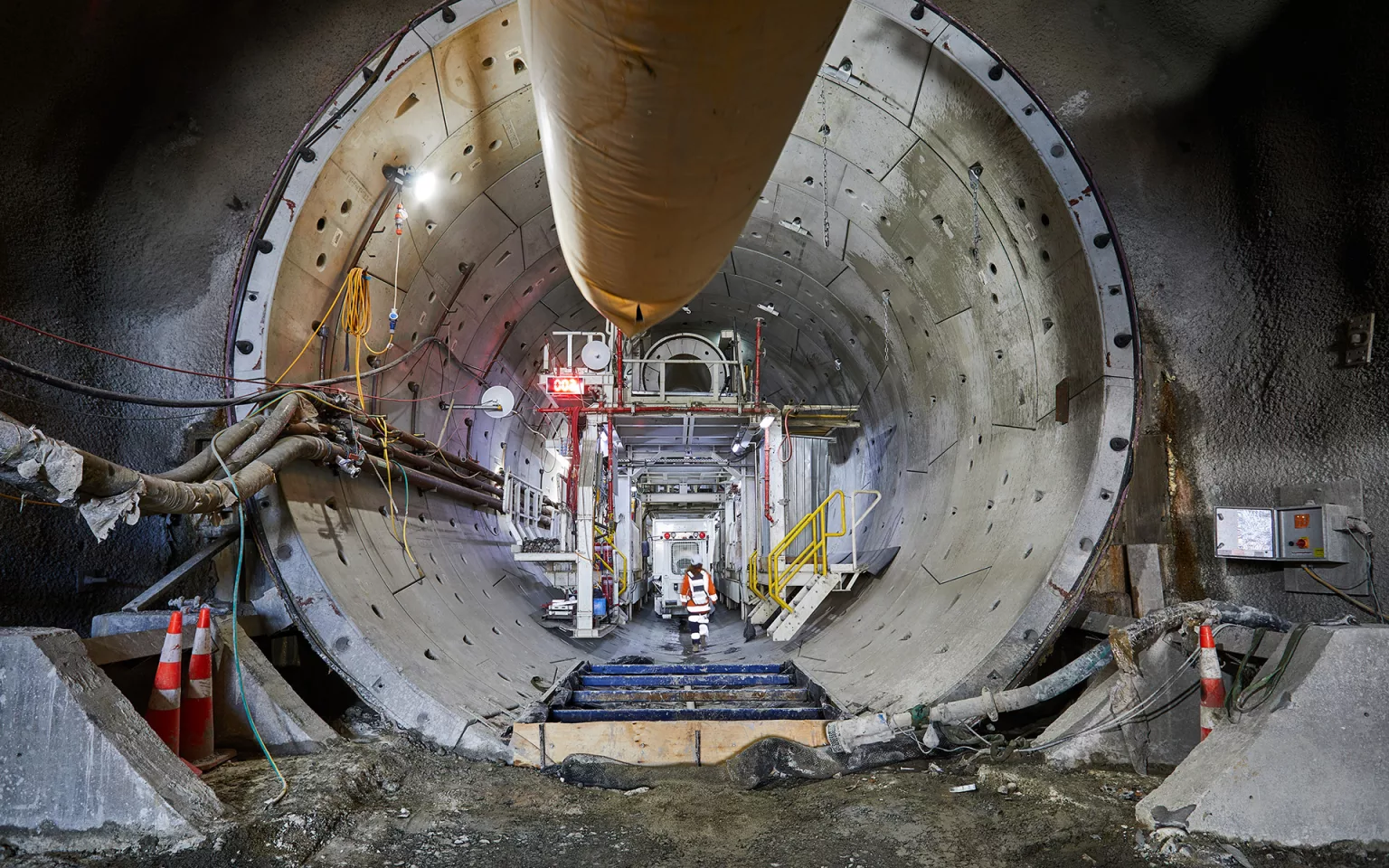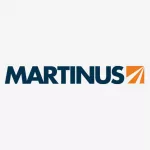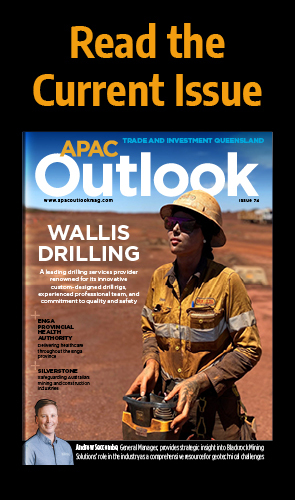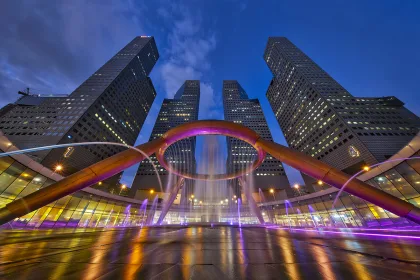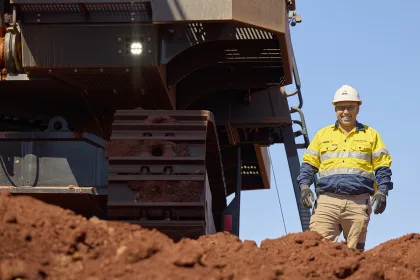Auckland’s City Rail Link is the largest infrastructure development project ever undertaken in New Zealand’s history. We take a look at Link Alliance, the consortium of companies involved, and speak to Project Director Francois Dudouit about large-scale boring, and an update on the megaproject’s progress.
NEW ZEALAND’S NEW METRO
Transport is constantly evolving to become greener, smarter and more efficient, and therefore requires the infrastructure to match.
In Auckland, New Zealand, City Rail Link (CRL) stands as the largest project of its kind ever to have been undertaken in the country and is set to reshape public transport and interconnect the Auckland region. Link Alliance is a consortium of seven New Zealand-based and international companies, including the client City Rail Link Ltd (CRL Ltd), which is delivering the main stations and tunnels for the CRL project.
The consortium also comprises construction partners Vinci Construction Grands Projects, Downer NZ and Soletanche Bachy International, and design partners WSP, AECOM and Tonkin + Taylor, to which the future owners and operators Auckland Transport and Kiwi Rail are associated.
CITY RAIL LINK
Transport in New Zealand currently relies heavily on roads and to a much lesser extent on air transport. Therefore, there are a lot of opportunities to develop rail infrastructure in a large city like Auckland and across the country, with rail infrastructure seen as one way to decarbonise the economy.
“The CRL is the first underground metro project in New Zealand and can be considered as a pioneer, which is definitely exciting and motivating,” begins Francois Dudouit, Project Director of Link Alliance.
CRL’s world-class rail system will better connect Auckland’s entire rail network; there will be more trains and journeys will be easier and quicker. The twin 3.45-kilometre (km) tunnels, which have been built up to 42 metres (m) below the Auckland city centre, will connect downtown at Waitematā Station (Britomart) with a re-developed Maungawhau/Mount Eden Station on the Western Line. Two new underground stations will open up central city access: Karanga-a-Hape (Karanghape) with entrances at Mercury Lane and Beresford Square, and Te Waihorotiu (Aotea) at Victoria and Wellesley Streets, midtown.
The work will transform the downtown Waitematā Station into a two-way through-station, and once complete, the project will allow the network to run at double rail capacity.
“The CRL is a metro project which will be a game changer for Auckland’s transport network when it opens,” Dudouit continues. “It is a turnkey project which includes the delivery of three stations (two of them being underground), the associated running tunnels, all electrical and mechanical equipment and rail systems, as well as testing and commissioning. It is the first metro project and the largest-ever transport infrastructure project in New Zealand.”
CRL will double the number of people within 30 minutes of central Auckland – New Zealand’s biggest employment hub. When fully operational, 54,000 passengers an hour will use CRL stations at peak times. More than 2,000 people are building CRL; according to Dudouit, this project innovation and complexity is upskilling a workforce to benefit future generations, and an alliance delivery model was selected with due consideration to the size of the project, its complexity, and the risks.
“Delivery of the heavy civil works started mid-2019 and has progressed well in a COVID-19 environment with the project now transitioning to delivery of the architectural and system works,” he reveals.
“The CRL is a metro project which will be a game changer for Auckland’s transport network”
Francois Dudouit, Project Director, Link Alliance
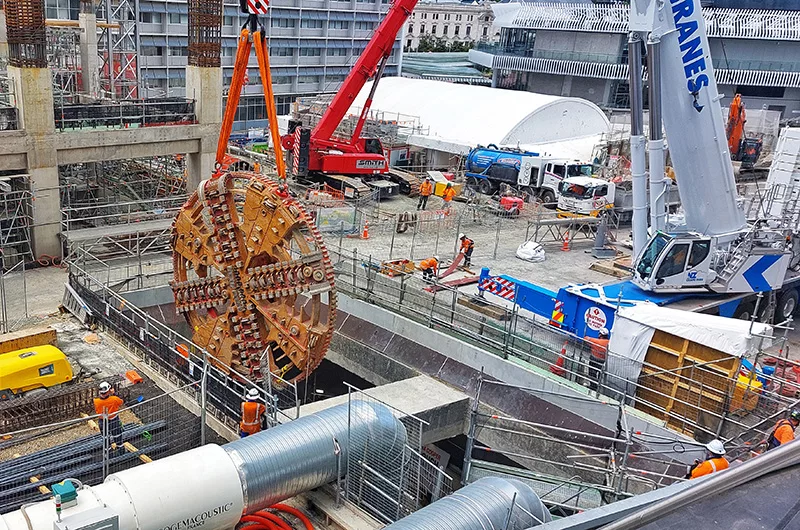
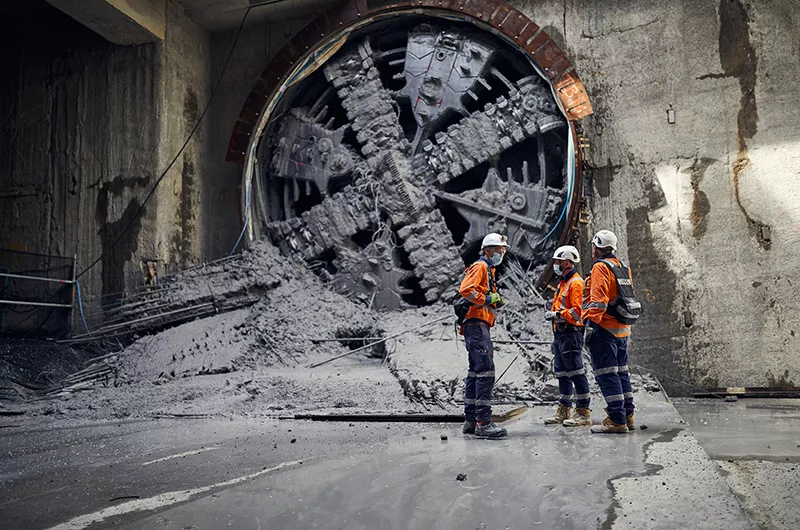
CARVING A PATH
Large-scale tunnelling is a core operation within the project. The parallel tunnels MC30 and MC20, each with a drilled length of 1.6km, are located in the geological area called East Coast Bays Formation (ECBF).
In the past, several tunnels had been dug with a tunnel boring machine (TBM) in the ECBF: Orakei Main Sewer, Rosedale Outfall and Waterview Connection. Based on this experience, an earth pressure balance (EPB) TBM supplied by German tunnelling machine manufacturer Herrenknecht AG was selected with a drilling diameter of 7.15m, a maximum pressure (Pm) of four bar, a cutting wheel equipped with ‘rippers’ and cutters for hard layers, and an opening percentage of 44 percent to overcome possible clogging.
Spoil, the soil and rock excavated when tunnelling begins, was transported out of the TBM via a conveyor belt with a capacity of 600 tons-per-hour (Tph) and transport within the tunnel was mainly undertaken by electric vehicles (EVs).
“The tunnel lining consists of precast rings, each 30 centimetres (cm) thick and reinforced with steel fibres, with the exception of special areas where reinforced cages were used,” Dudouit elaborates. “There were multiple primary technical challenges when it came to the bored tunnels.
“The first of these was tunnelling on a downward slope of 3.5 percent, and an alignment with a very tight radius (140m), even when starting the TBM. The TBM and tunnel equipment and the tunnel lining had to be designed specifically for such a small radius.”
A passage was also undertaken beneath the most important motorway junction in the city of Auckland (a 200m wide corridor with 11 lanes of traffic). In this area, the TBM progressed very quickly while being in closed mode, and settlements were limited to two millimetres (mm).
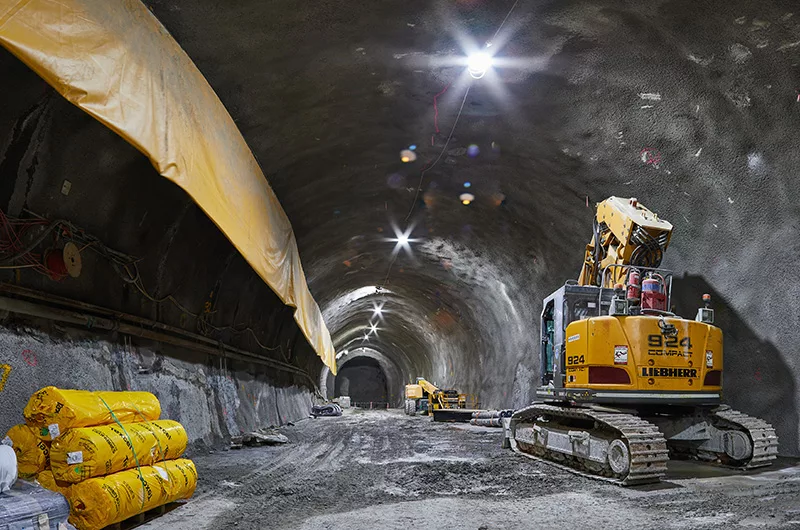
SUBTERRANEAN SERVICING
On top of this, there posed the issue of navigating passage regarding the anchors – steel strands cast-in construction supports – of the Aotea Centre, a performing arts and events centre located in the heart of Auckland.
According to Dudouit, these anchors were installed several decades ago during the construction of the Aotea Centre and left in the ground. Investigation work was necessary to ensure the number, position, length, technical characteristics, and that they were no longer under tension. Due to problems of access and utilities diversion, it was hardly feasible to remove the anchors from the surface. The remaining solution was therefore to remove these obstructions from the TBM.
“In order to facilitate this task, the TBM cutterhead was designed with knives and the screw conveyor with many access hatches,” Dudouit explains. “The operating instructions of the TBM have been adapted to this area. The passage of the anchors on both TBM drives was carried out without long stops and the TBM was able to progress at a very satisfactory average rate of 10m a day, validating the technical choices.”
The first TBM drive (on the MC30 tunnel) was completed in December 2021. After the start-up phase, the TBM achieved an average rate of 30 percent better than the 15m a day initially planned.
“The lessons learnt on the first drive enabled us to further improve productivity on the second drive, which was completed in September 2022. The TBM and the associated equipment are now fully dismantled,” Dudouit states.
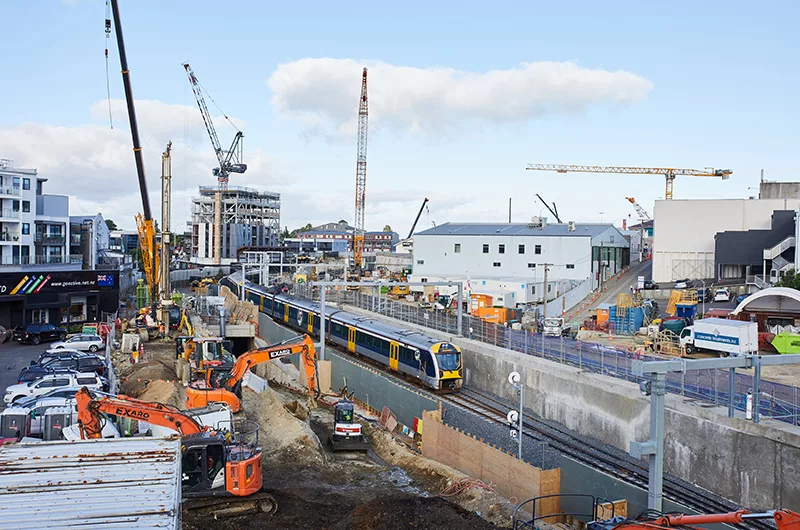
ALLIANCE IN AUCKLAND
Following the completion of TBM-related activities at Maungawhau, Link Alliance’s focus shifted to finishing the remaining civil works associated with Maungawhau/Mount Eden Station, namely the station building, train platforms, grade separated structures on the east and west sides, and starting the architectural and systems fit out works.
The North Auckland Line (NAL) works will be completed and both tracks in operation by mid-2023. In previous years, due to the sequencing of the works, trains operated on a single line through the work site. Works will be completed during the block-of-line (BOL), a period when no trains travel on the rail tracks, enabling construction to safely take place unimpeded.
“This was successful thanks to efficient works preparation, the commitment of the team and collaboration with Auckland Transport and KiwiRail,” Dudouit affirms. “To deliver such a complex infrastructure project in a challenging environment, it is key to first invest in people because they deliver the project. It starts by building a culture in which health and safety are at the heart, by investing in wellbeing, training, and developing people’s capabilities and talents.
“We rely on our team to deliver a very significant part of the work that we self-perform, and on our subcontractors to deliver the rest. It is important to establish strong and trustful relations with our subcontractors and suppliers. They should feel entirely part of Link Alliance and motivated to jointly deliver this project as a team.”
For Dudouit, investment in design and works preparation was made ahead of the start of on-site works, as adoption of state of the art processes and equipment, and promoting innovations, are key to the timely delivery and performance of works in a safe environment to reach the required productivity.
INFRASTRUCTURE EXPERTISE
CRL aims to make a truly national impact on New Zealand, changing the face of Auckland’s transport infrastructure to accommodate an ever-growing and busy region. Sean Sweeney, CEO of CRL, stands at the helm of the project, overseeing its progress as the largest of its kind in the country’s history.
Sweeney is an experienced executive with a proven history of leadership over large infrastructure projects in New Zealand, Australia, the US, and Europe. He is an engineer with a PhD in construction economics from the University of Melbourne.
“The CRL is now past the halfway mark, with tunnel boring complete and progressing well in the transition from civils to systems and the fit-out of the stations and tunnels,” he tells us.
The logistics for the tunnel fit out include more than 16km of rail track, 816km of signal cables, 247km low voltage cables, 86km traction cables, 74km cable containment, more than 5,100 square metres (m2) of metal cladding and more than 4,000m2 of glazing.
For Sweeney, the importance of the CRL to Auckland’s social, commercial, and economic health cannot be over-stated. It’s appropriate that public transport and investment in transport infrastructure are issues attracting attention in local and national debates.
“There is a large range of diverse challenges facing Tāmaki Makaurau (Auckland) and many of those are centred around population growth, with Auckland forecast to top two million people by 2033,” Sweeney informs us. “Effective and efficient public transport is the great enabler of great cities.
“It accelerates investment across the commercial and social economies, bolsters the arts, events, retail and hospitality sectors, and creates new businesses and new jobs. Highly effective, efficient, accessible public transport is a key enabler in any ‘international standard’ city and the CRL will be the catalyst for that important change in Auckland.”
“Effective and efficient public transport is the great enabler of great cities”
Sean Sweeney, CEO, CRLA NATIONAL IMPACT
CRL will deliver a multitude of benefits to the area including a world-class underground rail network capable of coping with up to 54,000 passengers per hour; doubled capacity across the rail network; a train arriving at a CRL station in less than 10 minutes; improved travel options and twice the number of Aucklanders within 30 minutes of the central business district (CBD).
“The CRL will also deliver significant economic benefits. A PwC analysis found the CRL will deliver total economic benefits of NZD$11.9 billion in the 60 years from 2022,” Sweeney tells us. “The biggest impact is on travel time for public transport users, which PwC has assessed as delivering NZD$4.543 billion in benefits across the next 60 years.”
Agglomeration benefits worth NZD$4.229 billion are also being delivered via the project. Agglomeration is a broad-based measure that accounts for the additional employment density and business investment which is expected to occur with the CRL. This leads to a corresponding lift in GDP as a result of increased productivity and economic output.
“The significant economic benefits serve to reinforce the importance of the project and more than justifies the public expenditure to complete it,” Sweeney adds.
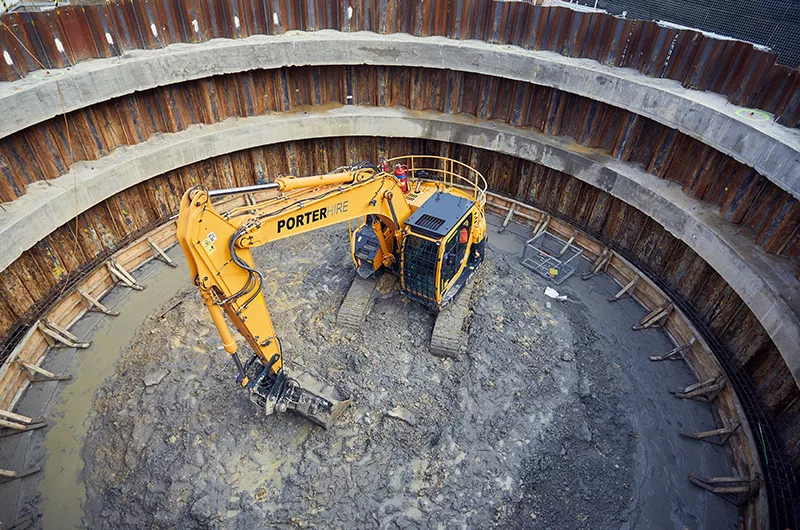
TRUST, RESPECT, COLLABORATION
Link Alliance is a truly international organisation with people employed by many different companies from both New Zealand and overseas. Team members are inducted into the alliance from a range of technical disciplines to deliver the overall programme of works for the CRL project.
The alliance’s induction helps team members understand the project scope, who is part of the team, what the project’s core objectives are, how an alliance works, and the importance of the alliance charter – the document which sets out the project’s overarching mission, values and accepted behaviours for working together as one team. The project’s mission is to ‘transform Auckland with a rail network people love to use’.
Key values include Hui ē tāiki ē (working together as one team where trust, respect, collaboration and inclusion are valued); Pono tauutuutu (holding each other accountable through being reliable, responsible, decisive and committed); Aroha tauutuutu (Caring for each other through wellbeing initiatives, being supportive, making work enjoyable and being mindful of the wider community), and Marohi te tū (being inspired through passion, empowerment, being courageous and proud of the project they are all delivering).
“The day-to-day operating rhythm of the alliance provides people with opportunities to openly participate in a range of toolboxes, meetings and other team forums,” Dudouit details. “These forums acknowledge people’s individual and collective efforts through Charter Champion awards. Anyone in the team can nominate a person or team for going above and beyond – whether it be living one of the charter values, collaborating with others to achieve a milestone, focusing on a key project objective or delivering a health and safety initiative – and these people are acknowledged and recognised in front of their peers.”
PEOPLE-CENTRIC SUPPORT
CRL is one of New Zealand’s few megaprojects that has the opportunity to significantly contribute to the legacy of the wider construction industry. Training and providing team members with learning opportunities are at the heart of Link Alliance’s recognition efforts to empower team members.
Significant time and energy support people to develop as leaders including leadership coaching and a focus on being constructive, upfront and solutions-driven. A bespoke training centre gives new team members a hands-on experience to learn about health and safety before they start work on-site. On top of this, upskilling opportunities enable people to progress both within the alliance but also in the future when they move on to other projects and opportunities.
“Our Wellbeing Team focuses on people’s wellbeing across all work sites and champions a supportive workplace for our people as well as building resilience to cope with an ever-changing environment,” Dudouit tells us proudly. “A range of wellbeing initiatives are undertaken each year to empower people to look after themselves, their work colleagues and their families.
“Examples include diabetes and blood pressure health checks, skin cancer awareness, fundraising for charities, blood donations, family days, touch rugby teams, bike rides, care packages and regular gatherings onsite where people celebrate and enjoy team successes together.”
Information about the alliance’s wide-ranging social outcomes initiatives is available at https://www.cityraillink.co.nz/social-outcomes.
EXTENDING NEW ZEALAND’S POTENTIAL
CRL railway works are to be carried out in two distinct environments, the first defined by the newly built structures (“greenfield”) and the second near tracks in circulation of the NAL. The phasing of the works is then dependent on the scheduled block of lines (planned periods without traffic) and takes place within a very strict regulatory framework.
On the sites, heavy civil works are now close to an end, and architectural and systems fit out works have commenced. This transition is an important phase in the life of the project and has required great attention upstream in the design phases of the civil and systems packages, engineering, and preparation of the works, in order to ensure that the integration is successful and that the project progresses as planned.
“Moving to the testing and commissioning phase is another critical transition. This phase is scheduled to start in 2024,” Dudouit explains. “The rail system teams integrated into the project are already working to define the tests, in order to validate the nominal operation subsystem by subsystem in interaction with the other subsystems.
“Although it is the future heart of Auckland’s rail network and will fundamentally change the dynamics of this network towards a metro-type operation, CRL must be primarily considered from a technical perspective as a network extension. In particular, the technology of the main systems, such as signalling, is unchanged. The rolling stock supplied by Auckland Transport is the same, which limits the risks during the testing and start-up phases.”
The establishment of the test plan is done in collaboration with the future owners and operators of the CRL (two entities that participate in Link Alliance): Auckland Transport for the stations and KiwiRail for the rail infrastructure, in order to secure the testing and commissioning process and the success of handing over the largest transport infrastructure network in New Zealand.
CRL represents a step forward in the nation’s infrastructure transport space, helping connect people across the Auckland region with a greater, greener and more efficient system. Estimated to be capable of transporting tens of thousands of passengers per hour, CRL will be an open and accessible network for all, bettering the lives of commuters and visitors alike.



